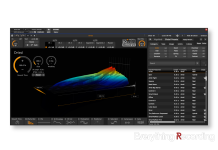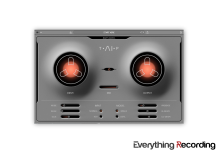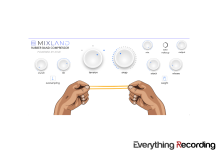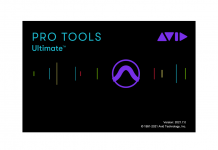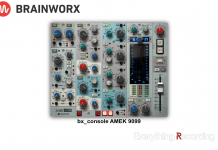Today, Kush Audio throws everyone a complete curveball by releasing a new “co-branded partnership” venture with A-Designs. A while back, Gregory Scott had mentioned to Everything Recording that due a new streamlined process of coding his DSP creations, that more products would be released more frequently. Initially, we thought this meant more Kush plugins which was already great news. We did not expect for the company to move into assisting other hardware manufacturers with DSP versions of their gear. What makes this new chapter in Kush Audio so great is that, in line with Gregory Scott’s tendency to make unique products, we most likely won’t be getting reinvented versions of gear already “plugified”. Kush Audio will open the doors to different boutique pieces of gear debuting as plugins. We start this journey off with A-Designs Hammer EQ… and we got a sneak peek before launch.
The Hammer is a tube based dual-mono, 3 band stepped frequency EQ with a “floating Q” that varies by how much gain is being applied and the actual frequency and dynamic content of the audio. Each channel has 6 knobs (3 detented knobs for fixed frequencies and 3 volume knobs, one for each frequency) and 3 switches (one for EQ in / out, one for 84Hz low cut filter, and another for an 8kHz Hi Cut filter). Some of the added features for the DSP version is a choice of independent dual mono, or linked stereo operation and output trim control.
The Hammer DSP functions like the original HM2EQ and not exactly like the Hammer 2. The main difference between the HM2EQ and the Hammer 2 is the Hammer 2 has a few more frequencies and the option for shelving on the corner low and high frequencies. The Hammer DSP features proportional Q bell filters throughout all frequencies. What sets this EQ apart from most of the others is how this floating Q responds to music. It’s actually very ingenious. Instead of either boosting the peak of a frequency at a set interval or with a gain / Q interaction whereby the Q changes as the gain is increased or decrease, Hammer will adjust the Q based on the amount of gain applied (or not applied), the actual dynamic material coming into the EQ, and the frequency content. This creates a living, breathing interaction that differs from track to track. Because of this unique approach, the EQ responds TO the music, not vice-versa. This gives a “musical” (I hate using these descriptions) quality to tracks. The EQ is essentially very “broad strokes” and tends to be used more as a blanket than a surgical tool. Even just instantiating the plugin gives a subtle bump in the low end to tracks and although this plugin is mainly used in stereo operations, it can just as easily be used on mono sources.
That in a nutshell pretty much explains the plugin. Simply decide whether Dual Mono or Stereo mode is needed, select whichever stepped frequency you want more or less of, turn the knobs, and immediately start smiling. I would be willing to bet money that this plugin will never leave your mix bus. Just about any application of this plugin renders incredible results. The proportional Q is a staple of Kush and SlyFi plugins and the Hammer DSP (literally) rounds out the collection. The Electra DSP has the tightest proportional Q, SlyFi’s Axis has a medium Q, and Hammer has the widest. Using all of these in combination gives infinite possibilities to tracks.
This EQ was designed for bass. The fixed frequencies provide the exact cuts and boosts needed for just about any tone desired. Acoustic guitars, vocals, synths all loved Hammer DSP. I found myself using the hi and low cuts with generous boosts on the lows and highs to obtain a Pultec-esc feel on tracks. Harsh audio immediately settles down when cutting with Hammer and even huge boosts on frequencies that usually wouldn’t be boosted obtains unexpectedly great results. I somehow fell in love with boosting 500Hz on my mix bus, which is something I usually wouldn’t think of doing. Try it… I bet it’s what your mix has been missing.
Sonically, I have absolutely nothing negative to say about Hammer DSP… Operationally, I have a couple of issues.
When changing from dual-mono to stereo, I lose my settings. Sometimes I like to stereo link controls then unlink to tweak each side. Each time I switch, my controls return either to default or the last state I left the plugin in before switching. I would also like to see a mid-side mode to sweeten the center and corners in different ways.
I also wanted to see some UBK-esque enhancements (sorry Greg, you’ve put this all on yourself with Axis!) Since Hammer DSP is tube based, I want to be able to drive that input circuit! I also want to be able to blend the drive with a wet / dry knob. I also would love to see UBK mode where the frequencies are sweepable, not because they necessarily are missing anything, but just to see how the plugin responds with different frequencies.
None of these missing features take away from the sheer greatness of the plugin and I suspect because this is Kush’s first venture with 3rd party hardware that discretion was used. I mean, how would you feel as a hardware company having someone not stay as close to the original as possible when making a plugin version of one of their prized pieces of hardware. I respect the commitment to keep as close to the hardware as possible. Who knows, maybe in the future a Kush original based similarly to the Hammer will show up. I’d buy that!
Overall this surprising new development is a refreshing new direction for Kush Audio and makes for a great version of an already unique piece of hardware. I can’t wait to see what “designed by Kush Audio” has in store next.
For more information and to buy, visit http://www.TheHouseofKush.com/





